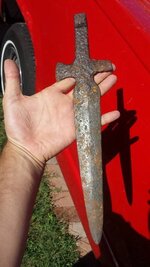Friend found this buried 2' deep. Any ideas?
Navigation
Install the app
How to install the app on iOS
Follow along with the video below to see how to install our site as a web app on your home screen.
Note: This feature may not be available in some browsers.
More options
You are using an out of date browser. It may not display this or other websites correctly.
You should upgrade or use an alternative browser.
You should upgrade or use an alternative browser.
Bladed Weapon found any ideas
- Thread starter whacker55
- Start date
RockRaven
Jr. Member
- Jan 19, 2015
- 77
- 55
- Detector(s) used
- Compass Challenger X80, Magnum 420, 220, RM6, Coin Mag, 77B, Yukon Nugget, Teknetics Delta 4000, Garrett AT Gold. Master Hunter ADS 7, CXII, Bounty Hunter Big Bud Pro 220, TR550, 840 Auto , Whites MXT
- Primary Interest:
- Prospecting
Can you post precise measurements? As per a previous post, there is a difference in the rate of corrosion of blade and handle. This indicates a possible forge weld between handle and blade. Often blades weye something along the lines of blister steel or wootz grade Indian subcontinent steel or Swedish steel, tangs and secondary metal could be wrought iron or low carbon utility steel. Viking blades combined wrought with crucible steel very early in European weapon history.
Many pikes did not have socket tangs, they would have had a long flat tang sandwiched between the pole-staff. Multiple other ways of fixing blades including clamp-type assemblies which might explain the protrusion on the tang. Could also be a repaired pike or a mountable multi-purpose dagger pike intended for use by a sailor.
My two cents as a blade-smith is that it is the real deal, Spanishad or Swiss pike.
Many pikes did not have socket tangs, they would have had a long flat tang sandwiched between the pole-staff. Multiple other ways of fixing blades including clamp-type assemblies which might explain the protrusion on the tang. Could also be a repaired pike or a mountable multi-purpose dagger pike intended for use by a sailor.
My two cents as a blade-smith is that it is the real deal, Spanishad or Swiss pike.
Upvote
0
Top Member Reactions
-
 3440
3440 -
 2226
2226 -
 2028
2028 -
 1159
1159 -
 1041
1041 -
 990
990 -
 842
842 -
 802
802 -
 790
790 -
 769
769 -
 760
760 -
 611
611 -
 570
570 -
 551
551 -
 549
549 -
 452
452 -
 439
439 -
 431
431 -
E
420
-
 409
409
Users who are viewing this thread
Total: 2 (members: 0, guests: 2)







